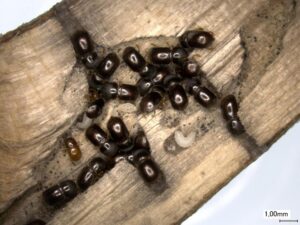Ambrosia beetles can recognise their food fungi by their scents

Nest of a fruit-tree pinhole borer (Xyleborinus saxesenii) with adult beetles and larvae. The yellow fungal mycelium of the food fungus is visible in the vicinity of the nest
Credit: Antonio Gugliuzzo / University of Freiburg
Experiments at the University of Freiburg provide evidence for the first time of the ability of ambrosia beetles to distinguish between food and harmful fungi.
Certain ambrosia beetles species engage in active agriculture. As social communities, they breed and care for food fungi in the wood of trees and ensure that so-called weed fungi spread less. Researchers led by Prof. Dr. Peter Biedermann, professor of Forest Entomology and Forest Protection at the University of Freiburg, now demonstrate for the first time that ambrosia beetles can distinguish between different species of fungi by their scents.
“The results can contribute to a better understanding of why beetles selectively colonise trees with conspecifics and how exactly their fungiculture works,” says Biedermann. “In addition, the scents of the fungi could be used to develop attractants to control non-native ambrosia beetles.”
Beetles orientate themselves by fungal scents

Credit: Antonio Gugliuzzo / University of Freiburg
A research team led by Biedermann and the environmental scientist Dr. Antonio Gugliuzzo from the University of Catania/Italy was able to show for the first time that the black stem borer (Xylosandrus germanus) perceives scents of its food fungi and that these act as so-called aggregation pheromones. This means that the beetle uses the scent of the food fungus to find trees that are already colonised by conspecifics. The beetle is an invasive species that is now widespread in Germany and is mainly found in fruit trees. The results have just been published in the journal Frontiers in Microbiology.
“Until now, we could not explain how these beetles attack trees in groups,” says Biedermann – because no corresponding scent of the insects’ own had been found so far. The experiment now showed that the beetles react to the scents of the specific food fungi that their conspecifics have already cultivated in the branches of a tree. “This enables the beetles to colonise weakened trees in greater numbers and to overcome the tree’s defences more easily, thus causing the tree to die,” says Biedermann. Further chemical analyses can now be done to determine a component of the fungus scent, which could then be used as an attractant for traps in fruit growing.
Even larvae can distinguish fungi
In another study, environmental scientist Denicia Kassie and biologist Janina Diehl were able to experimentally demonstrate for the first time that another ambrosia beetle species, the fruit-tree pinhole borer (Xyleborinus saxesenii), can recognise and distinguish between its food fungi and so-called weed or harmful fungi based on their scents. Diehl is a doctoral student with Biedermann at the University of Freiburg. “Depending on the condition of the fungi, the beetles in the experiments either specifically sought out the fungal cultures or avoided them,” says Diehl. The ability to recognise a potential threat to food fungi or their own health gives the beetles the opportunity to react – and either avoid or specifically combat the harmful fungi. The results of the study have been published in the journal Symbiosis.
The scientists were able to demonstrate the ability to distinguish between different food and harmful fungi in both larvae and adult individuals of the fruit-tree pinhole borer – which each take on their own tasks in the social network in the social maintenance of the food fungus cultures. “These findings are another building block to better understand how the control of fungal breeding by ambrosia beetles works functionally,” says Biedermann. “This could also result in ideas for our agriculture to control harmful organisms in a sustainable and environmentally friendly way.”
Factual overview:
• Original publications: Gugliuzzo, A., Kreuzwieser, J., Ranger, Ch. M., Tropea Garzia, G., Biondi, A., Biedermann, P. H. W.: Volatiles of fungal cultivars act as cues for host-selection in the fungus-farming ambrosia beetle Xylosandrus germanus. In: Front. Microbiol. 14:1151078 (2023).https://www.frontiersin.org/articles/10.3389/fmicb.2023.1151078/full
Diehl, J.M.C., Kassie, D., Biedermann, P.H.W.: Friend or foe: Ambrosia beetle response to volatiles of common threats in their fungus gardensSymbiosis (2023). https://link.springer.com/article/10.1007/s13199-023-00914-y
• Peter Biedermann is Professor of Forest Entomology and Forest Conservation at the University of Freiburg. His research interests include bark beetles, symbioses between insects and microorganisms, especially fungi, and the social behaviour of insects. Janina Diehl is a doctoral student at the University of Freiburg, Denicia Kassie wrote her bachelor’s thesis on the topic at the University of Freiburg. Antonio Gugliuzzo is a research assistant at the University of Catania/Italy.
• The research was supported by a DAAD scholarship for Antonio Gigliuzzo, by an Emmy Noether Grant from the DFG for Peter Biedermann and by funding from the University of Freiburg for open access publications.
Contact:
University and science communication
University of Freiburg
Tel.: 0761/203-4302
E-mail: kommunikation@zv.uni-freiburg.de
Weitere Informationen:
https://kommunikation.uni-freiburg.de/pm-en/press-releases-2023/ambrosia-beetles…
Media Contact
All latest news from the category: Ecology, The Environment and Conservation
This complex theme deals primarily with interactions between organisms and the environmental factors that impact them, but to a greater extent between individual inanimate environmental factors.
innovations-report offers informative reports and articles on topics such as climate protection, landscape conservation, ecological systems, wildlife and nature parks and ecosystem efficiency and balance.
Newest articles

Detector for continuously monitoring toxic gases
The material could be made as a thin coating to analyze air quality in industrial or home settings over time. Most systems used to detect toxic gases in industrial or…

On the way for an active agent against hepatitis E
In order to infect an organ, viruses need the help of the host cells. “An effective approach is therefore to identify targets in the host that can be manipulated by…

A second chance for new antibiotic agent
Significant attempts 20 years ago… The study focused on the protein peptide deformylase (PDF). Involved in protein maturation processes in cells, PDF is essential for the survival of bacteria. However,…





















